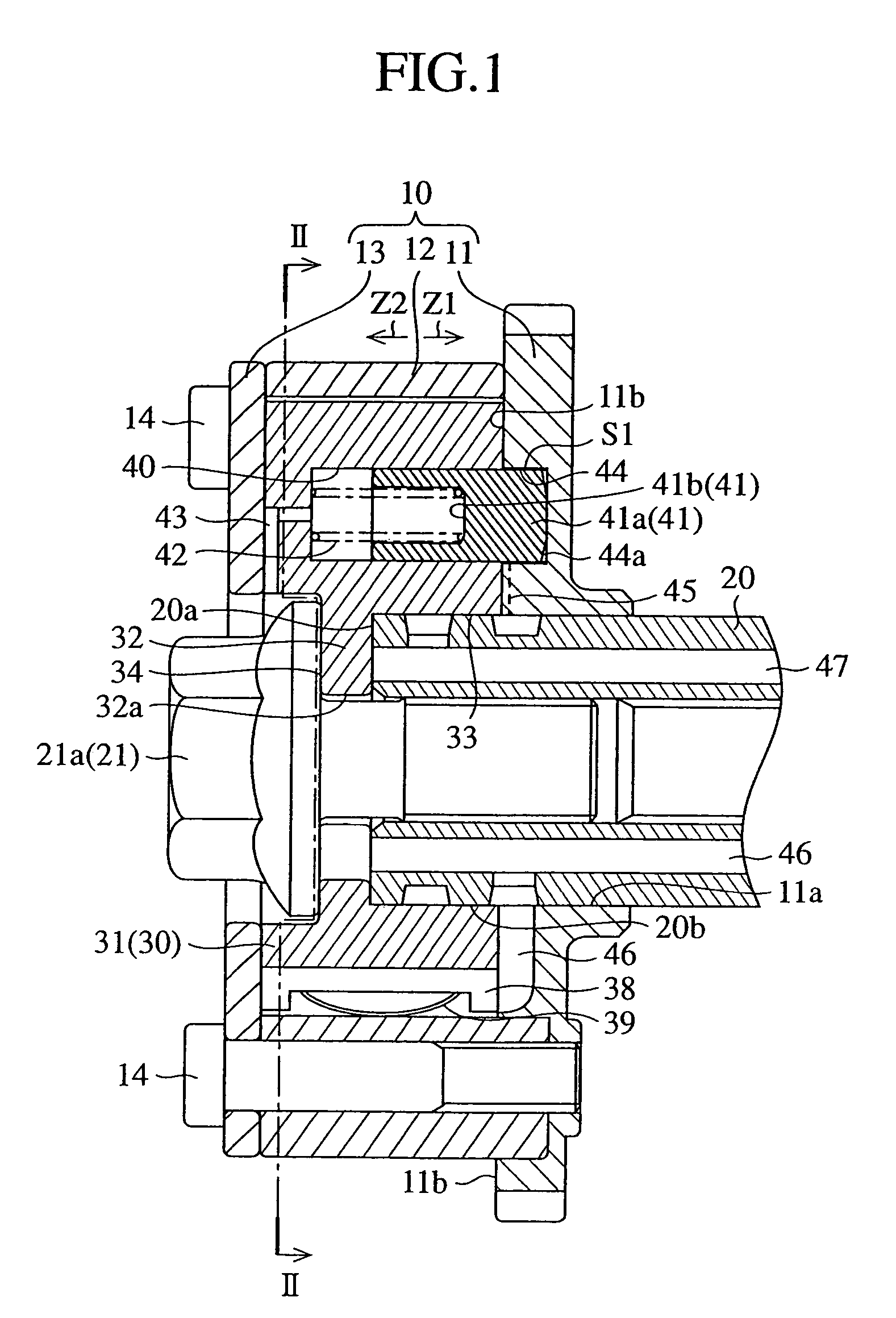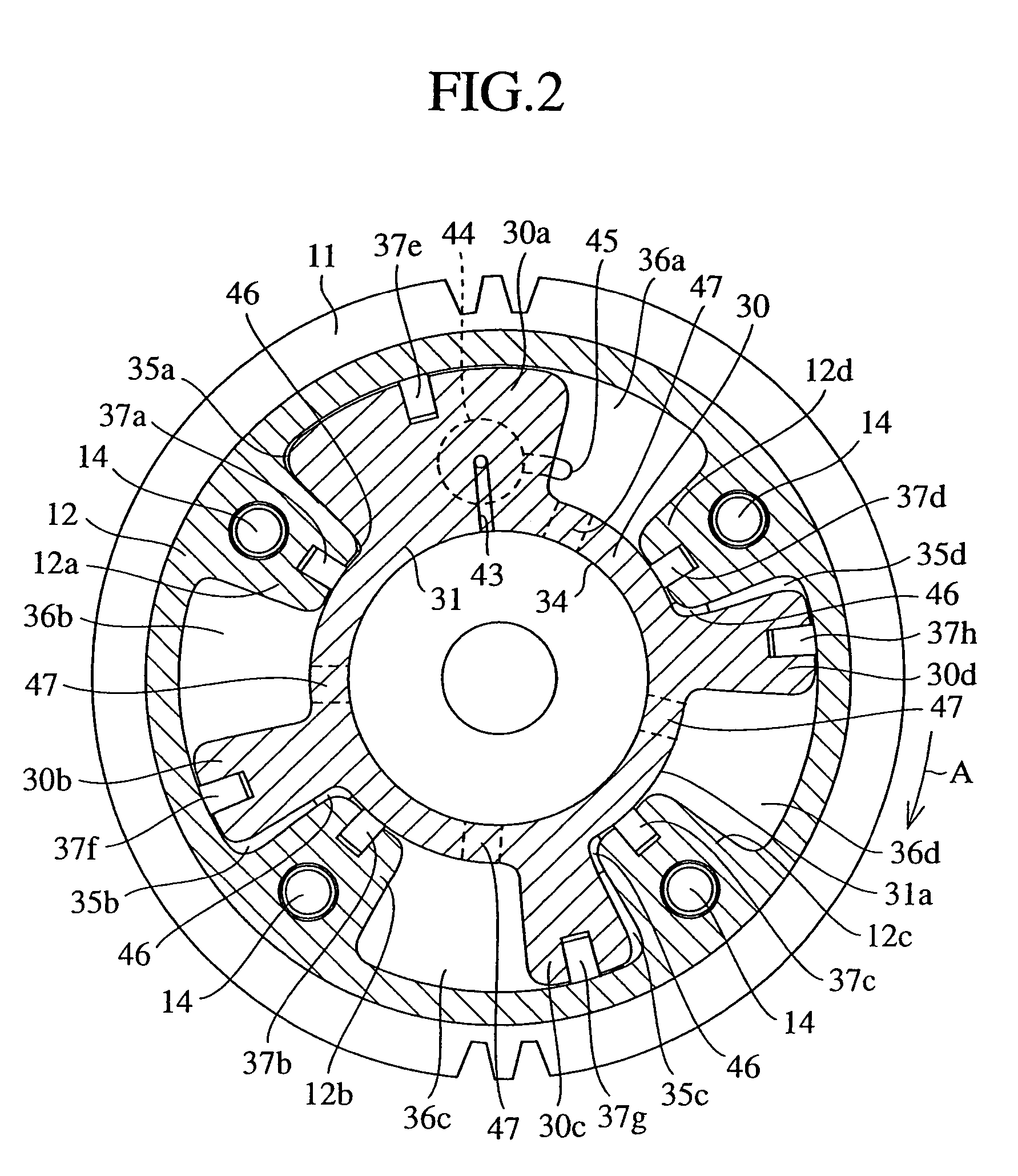Valve timing adjusting device
- Summary
- Abstract
- Description
- Claims
- Application Information
AI Technical Summary
Benefits of technology
Problems solved by technology
Method used
Image
Examples
first embodiment
[0025]FIG. 1 is an axial sectional view showing an internal structure of a valve timing adjusting device according to the first embodiment of the present invention; FIG. 2 is a radial sectional view taken along line II—II in FIG. 1; and FIG. 3 is an axial sectional view showing a sprocket of the valve timing adjusting device shown in FIG. 1.
[0026]A valve timing adjusting device 1 is generally composed of a first rotor 10 connected with a crank shaft (not shown) of an engine (not shown) by a power transmitting member (not shown) such as a chain and rotating synchronously with the crank shaft, and a second rotor 30 integrally fixed on an end face of a camshaft 20 of an intake side or an exhaust side camshaft (hereinafter referred to as a camshaft) by a bolt 21 and provided relatively rotatably within the first rotor 10 by a predetermined angle relative to the first rotor. The valve timing adjusting device 1 has, as will be described later, a structure of so-called axial lock, in which...
second embodiment
[0048]FIG. 4 is a radial sectional view showing an internal structure of a valve timing adjusting device according to the second embodiment of the present invention; FIG. 5 is an axial sectional view taken along line V—V in FIG. 4; FIG. 6 is an enlarged radial sectional view showing an engaging hole shown in FIG. 4 and a rotation regulating member engaging into the engaging hole; and FIG. 7 is an enlarged radial sectional view showing the engaging hole shown in FIG. 4 and the rotation regulating member disengaged from the engaging hole. In the second embodiment, the same components commonly used in the first embodiment are designated by the same reference numerals, and therefore explanation thereof is omitted for brevity's sake.
[0049]Despite of a valve timing adjusting device that is the most lagged position lock type device as with the first embodiment, the feature of the second embodiment is in that the second embodiment having a so-called radial lock structure, in which the rotat...
third embodiment
[0062]The feature of the third embodiment is in that an oxide film forming process is adopted as surface treatment to an internal surface of the engaging hole and a surrounding area of opening of the engaging hole (region) in the first embodiment or the second embodiment. That is, applying the oxide film forming process such as the “Alumite” (registered trademark) process to the internal surface and the surrounding area of opening of the engaging hole formed in either of the first rotor and the second rotor provides the region with satisfactory mechanical strength or surface hardness enough for resisting deformation of the engaging hole and wear-out of an edge of opening of the engaging hole caused by putting in and out of the rotation regulating member.
[0063]Here, the Alumite (registered trademark) process is a well-known surface treatment technology dedicated to anodization of aluminum to form a corrosive oxide film thereover when the member in which the engaging hole is formed is...
PUM
| Property | Measurement | Unit |
|---|---|---|
| Mechanical strength | aaaaa | aaaaa |
| Hardness | aaaaa | aaaaa |
Abstract
Description
Claims
Application Information
 Login to View More
Login to View More - R&D
- Intellectual Property
- Life Sciences
- Materials
- Tech Scout
- Unparalleled Data Quality
- Higher Quality Content
- 60% Fewer Hallucinations
Browse by: Latest US Patents, China's latest patents, Technical Efficacy Thesaurus, Application Domain, Technology Topic, Popular Technical Reports.
© 2025 PatSnap. All rights reserved.Legal|Privacy policy|Modern Slavery Act Transparency Statement|Sitemap|About US| Contact US: help@patsnap.com



